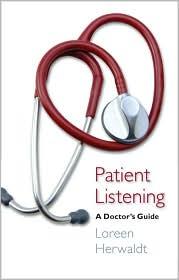Patient Listening: A Doctor’s Guide

We talked for 45 minutes. It didn’t take much. You’re not asking them to be a guru, a Tibetan monk, a psychologist, or practice in a different field. Just ask one more question, two more questions. Somehow everything comes into place much quicker.
This patient’s story captures the meaning of this collection of prose by twenty-four writers who have extensive experiences as patients. Loreen Herwaldt is a physician and educator in Internal Medicine and Epidemiology at the University of Iowa who selected close to one hundred pieces in Patient Listening in order to help students and medical practitioners appreciate the importance of communication and listening in their service.
An introduction and additional section, along with responses from other professionals, orient educators and practitioners on how to use this book. Here, a section of prose by a patient summarizes the purpose of what follow, “Medical training is fantastically narrow and intensive. It has to be…I’m not saying doctors need to go to liberal arts college…but I think it would be important to get the patient’s point of view.”
The patients' experiences are negative and positive, sometimes both are heard from the same author. Some experience alienation, for example, while overhearing a teaching physician excitedly pegging her as “a great case” and telling students “[t]hey were going to have an opportunity to do things they didn’t normally do.” Another appreciates a statement made by a surgeon who suddenly gets that the two don't have a good rapport: “No, you’ve had enough trouble with your eyes, you’re not having trouble with your doctors as well.”
Patients also take responsibility for their own experiences: “I thought if I got really sick, people would pay attention.” Another woman, who had a bone marrow replacement, describes taking the advice of hospital staff: to put up a picture of herself when she was healthy, so friends would remember and other staff members would be more likely to treat her like a “normal” person. Another appreciative piece relates, “I could not imagine getting 87,000 phone calls the way my hematologist does and not being half crazy. But he’s not… When I see him he is incredibly focused… and he’s very compassionate."
On average, the prose in Patient Listening has a tone that is critical of patient-doctor relationships, but there are many positive examples interwoven. In short, this book would be helpful read for anyone in either of the “two classes” described by one author: the “healthy in white coats, calling the shots” and “the great cases.”